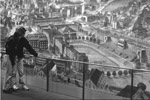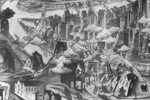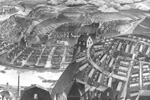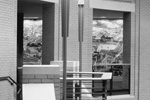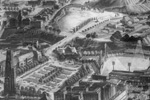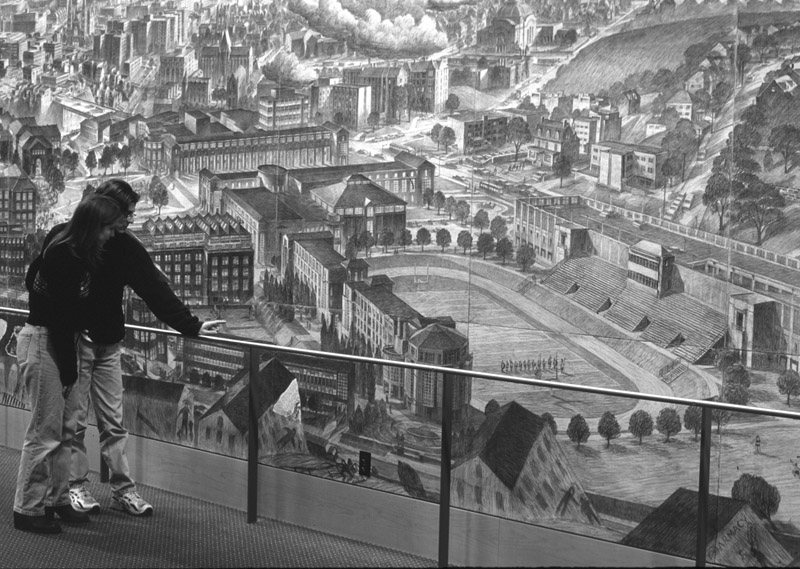
Carnegie Mellon University Center Mural (1996)

Artist: Douglas Cooper, Carnegie Mellon
Artist Assistants: Jonathan Kline + John Trivelli
About the mural...
When I saw the Rotunda in architect Michael Dennis' plans for the University Center, I immediately knew I wanted to do a mural there. Each of the peripheral walls of the Rotunda had its own compass orientation- east, west, and north. I thought I could use these to orient visitors to the campus and city as well as orient them in multiple time periods.
The Eastwall Mural: 1945 to 1965
The east wall shows Oakland in the foreground and looks across Junction Hollow to the campus as it appeared in its last years as Carnegie Tech when I was a student there. In the surrounding Oakland neighborhood, you can find Forbes Field, the former home of the Pirates, the Carnegie Museum before its 1970 addition, the Jones and Laughlin Steel Mill, the industry of the Monongahela River valley and the spectacular fire at the "Greeks", a favorite bar on Forbes Avenue.
The Westwall Mural: The present and future campus
Large in the foreground of the west wall as it looks across Junction Hollow to Oakland is the recently completed University Center as well as the soon to be realized Purnell Center for the Arts. Along the lower edge of the mural, I have incorporated personal anecdotes from the years 1965-70 when was a student in architecture at Carnegie Mellon.
The Northwall Mural: The Pittsburgh environment
The north wall mural, from left to right, follows the Monongahela River from present-day downtown Pittsburgh to McKeesport. Ducking in and out of the entrance alcoves into the adjacent ballroom, it depicts the city in several earlier times as well. You can find Exposition Park, the original home of the Pirates and nearby, Andrew Carnegie, who lived on Ridge Avenue overlooking the Park. Further to the right you can see the Tech campus as it appeared from 1920-40. The buildings of Henry Hornbostel's original plan form the core of the campus and some of the other buildings much loved by alumni from those first decades are there also. Further up-river are the Homestead Mill during the 1892 strike (the Pinkerton Barge is shown burning), the Turtle Creek Valley and Kennywood Park. Flying low over the Homestead Hi-level Bridge is the mystery plane that crashed in the river during the late 1950s and has never been found.
All three walls are designed to give viewers the sense that they can "walk into" the space depicted in the mural. Whether by turning corners into alcoves, as is the case with the Northwall Mural, or by extending full height from baseboard to the ceiling, as occurs throughout, the intention is to present no visible edges. The sense of the art work is not that of a picture on a wall, but of an edgeless view into a space beyond.
